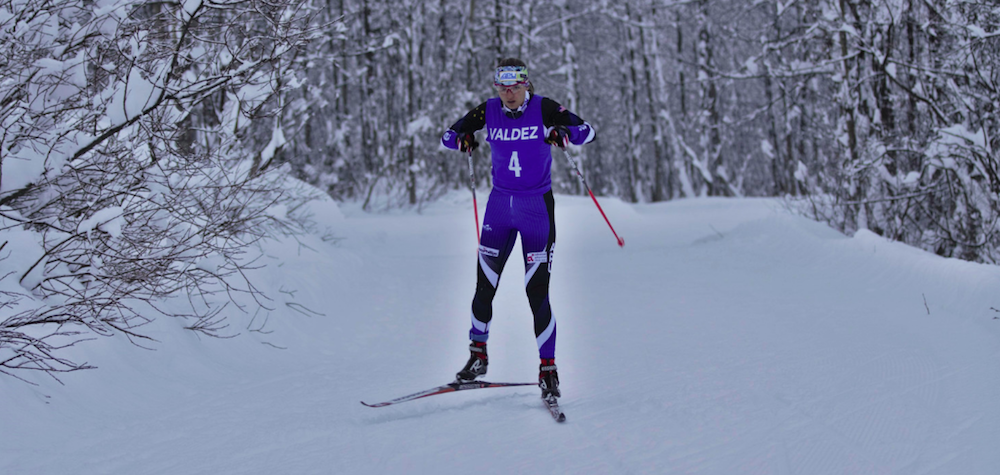
VALDEZ, Alaska — Official Winter Storm Warnings for the state of Alaska are graded on a curve. In Fairbanks, which has a relatively dry winter climate and low snowfall totals, a forecast eight inches of snow in 24 hours are required before the National Weather Service (NWS) will issue a warning. In moister maritime Anchorage, that figure becomes 12 inches in 12 hours. But in Valdez, world-famous for its deep snowfalls and epic backcountry skiing in the Chugach Mountains, the standard is a full 24 inches in 12 hours before a warning will issue. It’s forecast to snow 18 inches before noon? Three feet by the end of the day? NWS doesn’t want to hear about it.
All of which is to say that it was snowy in Valdez over the weekend for the third-annual Qaniq Challenge, but not historically so. Like, it only snowed roughly eight inches during the day on Friday, 14 inches Friday night, a few more inches Saturday, six or eight more inches on Saturday night into Sunday, and another foot or so on Sunday through Monday.
Paul (PK) Kovacs of the Australian National Team and Lauren Fritz of Alaska Pacific University (APU) romped through the fresh snowfall to pick up victories in the third-annual Qaniq Challenge, a two-day, roughly 35-kilometer total classic and freestyle race series. Notably, first place earned each of them $2,000 dollars, the second-richest prize in domestic cross-country skiing, behind the American Birkebeiner. The Qaniq’s total purse, $10,000, also trails only the American Birkie.
The Qaniq, whose name comes from the Alutiiq word for “falling snow,” has been held in a variety of formats during its three years of existence. This year’s race saw a 15.7 k freestyle individual start on Saturday, followed by an 18.6 k classic pursuit on Sunday. First racer to cross the finish line on Sunday wins.
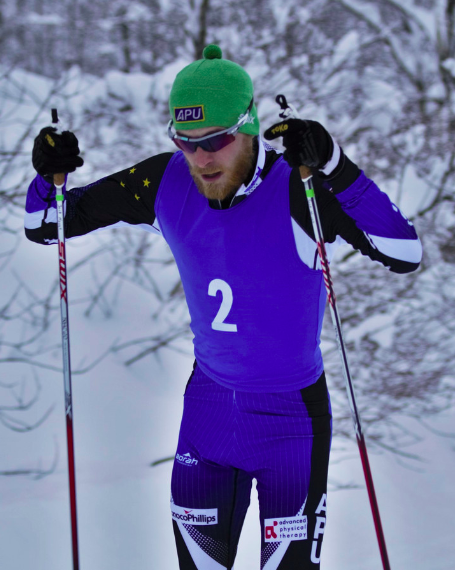
On Saturday, that racer was Kovacs. The Australian national, who lives and trains in Anchorage but is a member of the Australian National Team, started in bib 5, 90 seconds behind APU skier Jack Novak and a minute behind APU skier Andre Lovett. But roughly 16 kilometers later, it was Kovacs who was the first to return to the starting area plowed out of the 14 inches of fresh snow near the Coast Guard Housing on the western edge of a residential Valdez neighborhood.
Kovacs’s time for 15.7 k was a laborious 46:51.7. Novak (+2:11.7) and Lovett (+5:04.2) followed.
In the women’s division, Fritz (APU) skied to victory in 55:51.7. Kate Backstrum (citizen racer, formerly of Montana State University) in second (+5:49.5) and Krista Heeringa (citizen racer, formerly of University of Alaska Anchorage) in third (+7:57.3) made up the rest of the Day 1 podium. Fritz started somewhat ahead of them in bib 4, then skied by herself for nearly the entire course.
Saturday’s race was not easy for anyone, as a snow/rain/sleet mix falling on top of nearly two feet of recently groomed fresh snow, and temperatures around 34 degrees Fahrenheit with close to 100-percent humidity, made for slow going no matter how many fluoros were applied. Kovacs’s winning time on Saturday, for a 15.7 k skate race including 9 k of pancake-flat trail, was nearly 47 minutes. The previous month, at a Besh Cup race in Anchorage, he covered a much hillier, International Ski Federation (FIS)-certified 15 k course in 37:15. Last year he skied a World Cup 15 k in 39:10. Novak, in second, clocked a 35:40 for the Besh Cup skate, and a 49:03 in Valdez. Saturday was slow for everyone.
Sunday brought somewhat less fresh snow, down to eight inches or so (plus more falling during the race), but more of the same on the results sheet, as both Kovacs and Fritz maintained their lead in the classic race to win the overall title.
Novak had the fastest time on day on Sunday, pushing through the fresh snow in the classic pursuit start to finish in 56:52.0, 16 seconds faster than Kovacs. Lovett (+2:32.1) was again third. Those margins were not enough to change the overall podium based on combined times for both races: first Kovacs, then Novak (combined +1:55), then Lovett (combined +7:20).
Sunday was once more all Fritz in the women’s race. The APU skier fought through jetlag and energy issues to ski the classic race in 1:06:12.4. Backstrum (+5:31.9) and Heeringa (+11:24.7) again followed. The final podium was the same: Fritz, Backstrum and Heeringa.
If it’s Saturday, this must be Valdez
Despite Fritz’s large lead throughout the weekend, she never felt that her victory was guaranteed. Fritz had raced in China from Jan. 1-9, completing six races in nine days. Then she played tourist in Beijing for a few days. Then she made the not-short trip back to Alaska, arriving at the Anchorage airport at 4 p.m. on Thursday. Then she woke up on Friday and drove more than 300 miles to Valdez.
“I literally hadn’t skied in almost a week,” Fritz told FasterSkier of Saturday’s race.
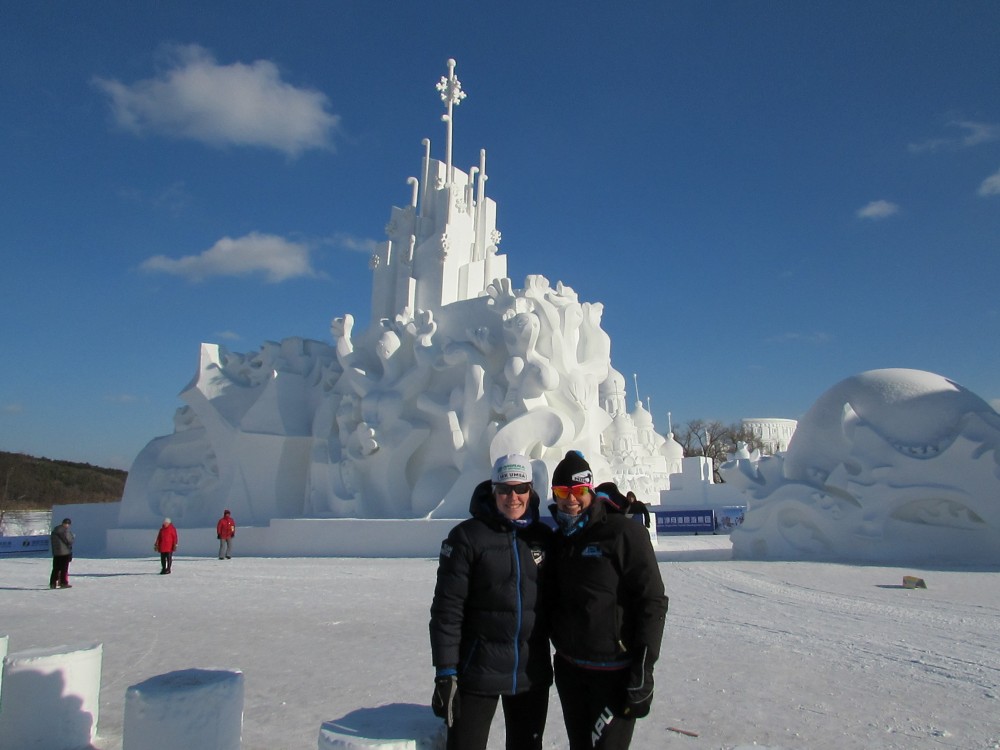
“I think my last race in China was like the 9th, which would have been the 8th here, and then after the race I spent a few days in Beijing, touring around, being a tourist, and didn’t run, didn’t ski. Didn’t have time when I got home. So literally [Saturday] testing skis, warming up was the first time I had been on skis or worked out in a week. And then with the delayed start, that kind of sucked, because I got kind of cold again. And I started, and I felt like I flooded on the first hill that was 500 meters out of the start, so I thought it was going to be a really, really rough race. But I think just having really good base fitness helps you keep it together.”
Base and experience and a six-minute lead notwithstanding, Fritz was taking nothing for granted on Sunday. Not in some Bill Belichick coach-speak sense of anodyne platitudes about taking all competitions seriously and not celebrating too early, but rather in the very real sense that her international travel schedule and recent nutrition issues left her honestly concerned about her ability to complete a flat 18 k double pole course.
“Don’t pass out on the side of the trail,” a relieved-but-tired Fritz said after Sunday’s victory. “That was pretty much my only strategy, because I was actually legitimately worried about something like that. Because I’ve been super low energy, because I lost a lot of weight in China, because it was like hard to eat a lot of stuff. So my energy stores are probably very much in a negative balance. So it was a legitimate concern, running out of energy, just falling over. But that didn’t happen.”
Fritz was able to complete Sunday’s race despite a second day of challenging conditions – with two minutes between her and the preceding racer in the pursuit start, enough snow would fall in those two minutes to make it difficult to discern which track the leading skiers had taken – and the effects of international travel.
“I definitely go through periods during the day where I get really, really tired and kind of, almost like dizzy and spacey, just really out of it,” Fritz said. “And then there will be like times in the middle of the night where I wake up wide awake for a like a couple of hours. So, this is definitely some pretty severe jetlag, I think.”
While the jetlag was pronounced, Fritz was unphased by Friday’s 300-mile drive to get to the race start.
“The, like, 5 1/2 hour drive from Anchorage to Valdez was – well, we did two five-hour drives, a 16-hour drive, and a 10-hour drive in China,” Fritz recounted of her recent travels for the China Tour de Ski. So “this was like pretty easy. It went by fast.”
(Men’s second-place finisher Novak went from China to Anchorage to Valdez on the same schedule. Novak’s father drove him from Anchorage on Friday, while Novak fils slept the whole way.)
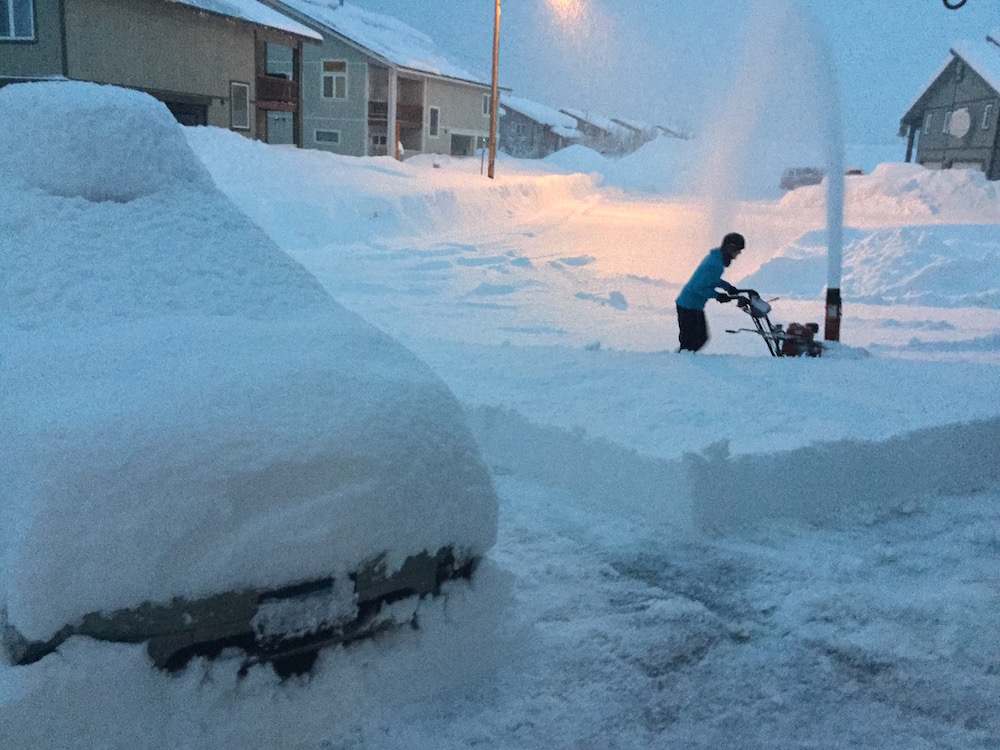
Fritz is the only skier to make the podium in all three years of the Qaniq Challenge, logging a cumulative first, second, and third since 2015. That’s $4,000 combined lifetime winnings from this race, including $2,000 this year.
So what does it mean for an American skier to win $2,000 in a ski race?
“It’s pretty big money,” Fritz said. “It’s more than a national championship. So that’s sweet. I mean, it’s such a cool race; I really hope that it can grow over the years.”
For Backstrum, meanwhile, a thousand dollars for second was apparently going to aid her with more quotidian concerns. “It feels like I have a good amount of beer money now,” Backstrum joked. “No,” she continued, “I didn’t get my PFD this year, so it will be a nice replacement.”
(The reference is to the Permanent Fund Dividend check, the payout given to all eligible Alaskans representing their share of the state’s sovereign wealth fund.)
Backstrum had graduated from Montana State in 2014, and had trained sporadically since then. “This was a good inspiration to start training again” for ski racing, she said.
For Kovacs, who also earned $2,000 for his victory in the men’s race, the cash prize was “huge.” It marked “the biggest paycheque I’ve ever received in any ski race,” Kovacs said. “It’s really helpful. I mean, that’s like four months’ rent back in Anchorage, or that will pay for all my flights to Europe and all my other flights in Europe for the season this year, which is just massive. So it’s a big help.”
Kovacs surveyed other races in which he had won money, and concluded that he had not quite won $2,000 in all other races in his career combined. “Maybe,” he said. “Probably just under. So this has probably, like, doubled my entire career earnings.”
The payout came in a race that Kovacs nearly did not enter. He had done some of the races at last week’s U.S. nationals, leaving Utah on Wednesday and returning to Anchorage only at 5 a.m. Thursday.
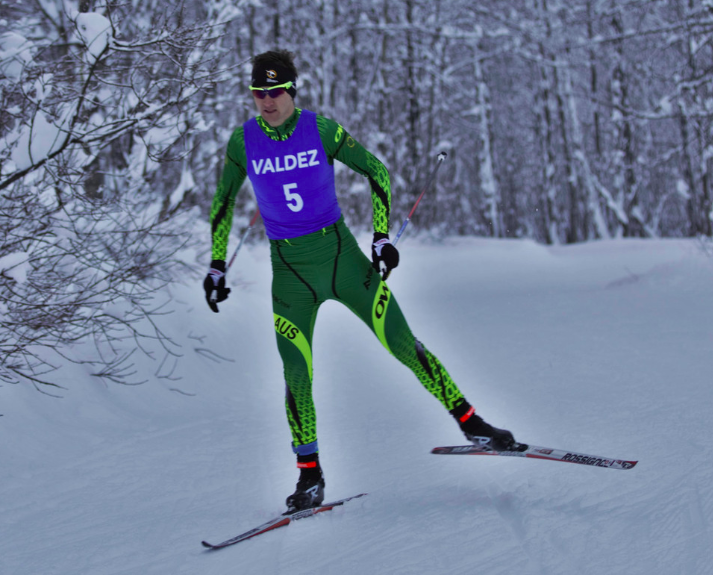
“I then picked up Lauren [that afternoon],” Kovacs said, “And she said, ‘Hey, I’m going to go to Valdez,’ and I said, ‘OK, well I guess I’ll come.’ Because up until that point I wasn’t even coming. I had originally planned to just have a few days at home before I fly to Europe. … It was a very last-minute decision, and we kind of just got up the next day, after doing a bunch of washing the night before, and just packed gear and went.”
Kovacs and Fritz have been an item for some time; on this trip, Kovacs was the more functional of the two. “I’ve been holding it together pretty well,” he said. “I’ve managed to get a lot more sleep than Lauren has. I know that Lauren’s been up at like midnight, and a few hours in the middle of the night the last few nights. But I definitely took a couple naps, for sure. We’ve been holding it together all right, but it’s definitely like, once we’ve finished today and tonight I think we’re going to take it easy for the next few days.”
“This has probably, like, doubled my entire career earnings.” — Paul (PK) Kovacs on his 2017 Qaniq Challenge victory
But not for too long – Kovacs flew to Europe today, for two weeks of training in Falun. He had World Cup starts lined up after that across Europe and Asia (Falun, Pyeongchang, and Otepää) before planning to race World Championships in Lahti.
Back in Alaska, Kovacs found conditions for Saturday’s race “really challenging. I mean, we’d had a lot of fresh snow, almost two feet of fresh snow. And they’d done a fantastic job to pack it and groom it, but it still was pretty aerated pack, so it was pretty spongy. And then we’d had almost torrential rain on top. And so it was just kind of that mashed potato sludge.”
Despite the trying conditions, Kovacs said, “I was fortunate, I had some really solid skis, and maybe coming from altitude … I was able to really attack it a lot harder, I think, than the other two guys. Who also had I think pretty bad skis.”
In a gracious gesture, following Saturday’s race Kovacs formed “a gentleman’s agreement” with the two APU skiers immediately behind him, “and they all came over and waxed the same wax at my house, which was good.”
Kovacs didn’t want to claim too much credit for nailing the wax on Saturday, saying, “Honestly, it wasn’t like I was a mastermind and figured it out.” (He then explained that he and Fritz had, in their jetlagged state, packed “just one or two” warm waxes, making their options easy to work through.)
Rather, Kovacs credited his grind, a Caldwell VDF, which he called “exceptionally good – that’s a chevron grind, and it was able to, I think, flush out the liquid in the snow much easier.”
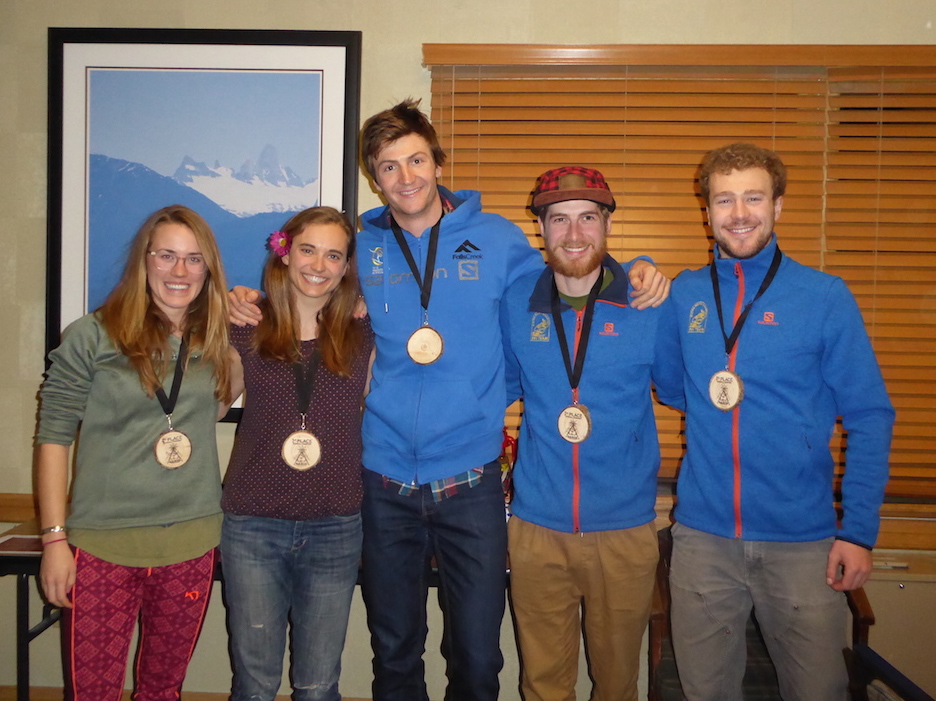
Kovacs’s approach for Sunday, when he had a two-minute lead in the pursuit, was simple: “Basically the strategy was to go out as hard as I could. … With double poling you don’t quite blow up, or I find I don’t blow up, aerobically so much as my arms just blow up. And so I just wanted to see how hard I could go.”
Being the first starter was disadvantageous in the fresh snowfall, but Kovacs benefited from a snowmachine that passed through moments before the race began, creating a firmer and less snowed-in platform than in either of the two set classic tracks. “My strategy was just to try and find fast snow,” Kovacs said, “And luckily a snowmobile had driven out some volunteers, and so I just skied on that.”
Kovacs appreciated the chance to see Fritz during one of the loops of the course.
“In a race like this, I definitely think about how Lauren is doing. I definitely was curious to see what was going on, and even just the fun things like racing against the master skier, and seeing how they’re going, because you know they knew each other, and how that was going duking it out, that’s fun. In other races I normally wouldn’t consider it; I do really try to just focus on my own race. But I guess in this race, because it just has more of a relaxed atmosphere, I let myself just think about other things a little bit more. So yeah, I was definitely curious to see how she was going. I mean, being so far out there, if you break a pole or lose a basket it’s a complete game-changer compared to a normal FIS race, where there’s a lot more people on the course that are able to give you equipment. So there’s more variables I guess here.”
Looking to the future
The Qaniq is universally beloved by those skiers who have made the trip to Valdez to race, reflecting quality organization and overwhelming community embrace of the event. But not that many skiers have made it: 31 in 2015, 37 in 2016, 33 this year.
So will there be a fourth year? Maybe. Hopefully. Not certain. Race organizer Darryl Verfaille is nothing if not optimistic.
The status of next year’s race is “truly undecided,” Verfaille told FasterSkier at the Sunday awards banquet, “but I’m going to do everything I can, even if I have to morph the format a bit. And we’re going to reach out – I’m going to do everything I can, including maybe seeking some external sponsors, maybe fundraisers. Some may change again with the political winds of Valdez, come next election, but I think we’ve got the city itself – the executive staff of the city of Valdez is in favor of this, because they recognize the true value, which is just exposing folks to Valdez in the winter. So I can’t say for sure we’re going to have it, but I’m going to do everything I can to make it happen for the fourth year.”
Both Fritz and Kovacs addressed the room at the awards banquet in brief unscheduled remarks, praising the race organization and experience and hoping for its continued success.
They also expressed similar sentiments in their comments to FasterSkier. “I think it’s a great race, and I hope they can keep it going,” Fritz said.
“It’s an extremely fun event,” Kovacs echoed. “And I heard next year with U.S. nationals being in Anchorage that a lot more people will make the choice to come down here and really give this race kind of what it deserves. Because the volunteers put in a phenomenal effort, and it’s probably one of the best atmospheres of any race I do anywhere in the world. It just is really fun, and people should get involved.”
The trip home
Back in Valdez in January 2017, the APU skiers and Kovacs spent Monday morning after the race conducting a free clinic for the Valdez High ski team. The remainder of the field began their journey home on the only road out of town, where they were treated to an official NWS Blizzard Warning for their drive home through Keystone Canyon and Thompson Pass, including another 12 to 18 inches of snow and winds to 40 miles per hour. In a bit of meteorological ecumenicalism, the criteria for a blizzard warning (snow reducing visibility to less than a quarter-mile and winds gusting to 35 mph for four hours or more) are the same throughout the entire country.
Gavin Kentch
Gavin Kentch wrote for FasterSkier from 2016–2022. He has a cat named Marit.
